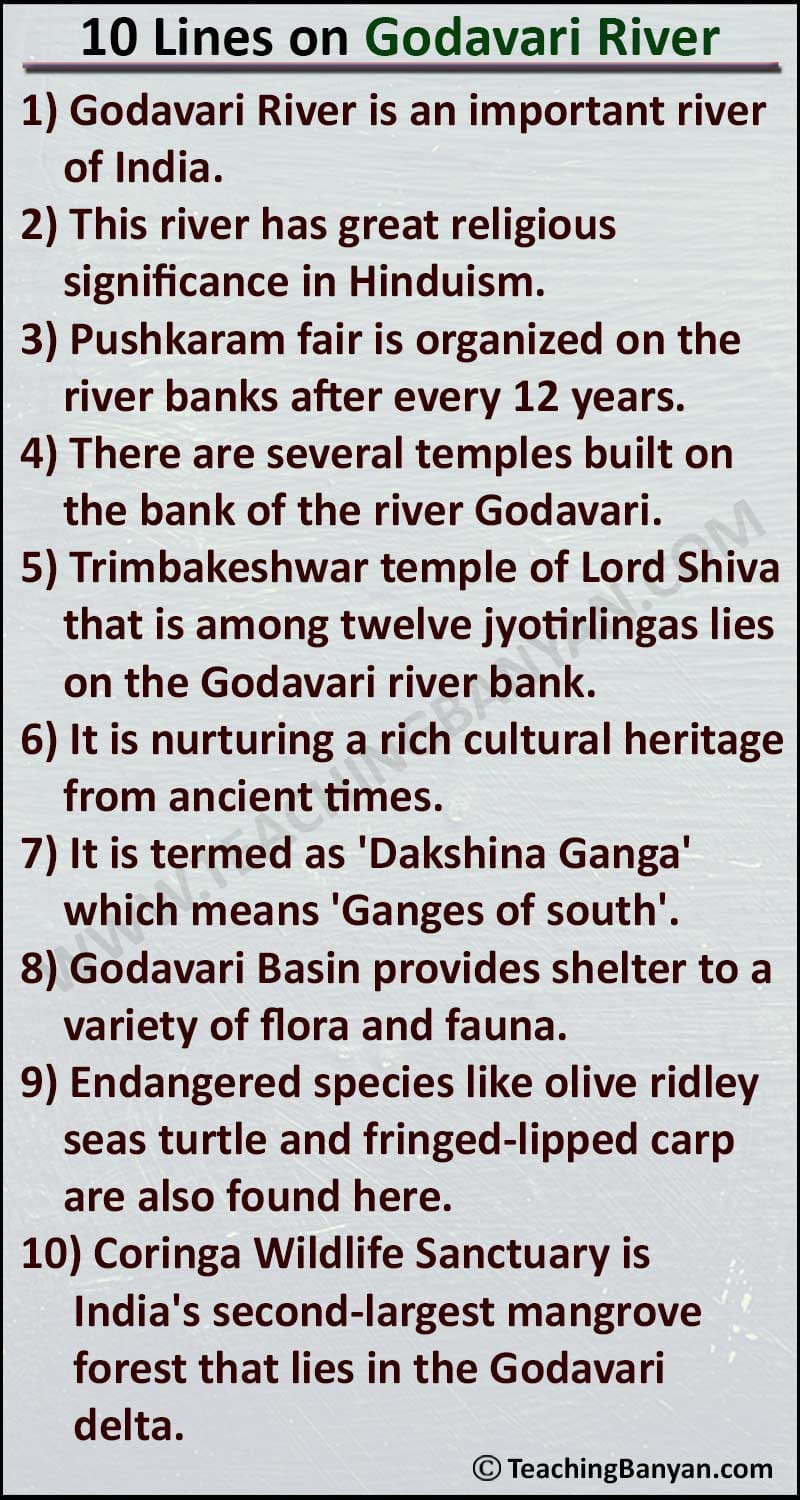Godavari River is a sacred river of central and south-east India. It is equally regarded and worshiped like River Ganga. Godavari River flows through many states hence it is a multi-state flowing river. It flows through Maharashtra, Madhya Pradesh, Chhattisgarh, Orissa, Karnataka, Telangana and Andhra Pradesh. Godavari is the second largest river after Ganga and largest in terms of length, coverage area and water discharge in Indian peninsula.
It also holds a religious significance and there are many pilgrimages situated on the banks of the river like Trimbakeshwar, Nanded Takht etc. The geology of Godavari River shows us that the Godavari River basin is rich in fertile alluvium as well in minerals like coal, bauxite, manganese etc.
Ten Lines on Godavari River in English
10 Lines on Godavari River
1) Godavari is the second-largest and sacred river of India after Ganga.
2) The river flows in the direction of central and south-eastern part of India.
3) Godavari is largest in Indian peninsula by its length, coverage area and water flow.
4) The length of Godavari River is 1465 km and the coverage area is 312,812 square km.
5) Godavari River originates in Nasik district of Maharashtra, 80 km from Arabian Sea.
6) The river splits into two distributaries before falling into the Bay of Bengal.
7) The annual average water flow of Godavari River is approximately 110 billion cm3.
8) Pravara, Purna, Manjira, Manair, Pranhita etc are some tributaries of Godavari River.
9) “Trayambakeshwar Jyotirlinga” in Maharashtra is situated on the banks of Godavari.
10) Indian Navy has named one of their warships as ‘INS Godavari’ based on this river.
10 Lines and Sentences on Godavari River
1) Godavari River emerges from northwestern India.
2) It is regarded as the second largest river in India.
3) It traces its course through Maharashtra, Chhattisgarh, Telangana, and Andhra Pradesh states of India.
4) Godavari River is 1465 km in length.
5) The area of the drainage basin of the Godavari River is 312812 square km.
6) Banganga, Kadwa, Shivana, Purna, etc. are the left bank tributaries of River Godavari.
7) Nasardi, Pravara, Sindphana, etc are the right bank tributaries of river Godavari.
8) Nasik, Nanded, Nizamabad, Rajahmundry, etc. districts of India lie on the bank of river Godavari.
9) The water of the river Godavari is least used for producing hydroelectricity.
10) Godavari River finally terminates into the Bay of Bengal.

5 Lines on Godavari River
1) The Godavari arises from North West India.
2) It is India’s second largest river.
3) It is also famous as Dakshin Ganga.
4) Its length is about 910 miles.
5) It passes through Telangana, Chattisgarh, Maharastra, etc.
20 Lines on Godavari River
1) Godavari River is an important river of India.
2) This river has great religious significance in Hinduism.
3) Pushkaram fair is organized on the river banks after every 12 years.
4) There are several temples built on the bank of the river Godavari.
5) Trimbakeshwar temple of Lord Shiva that is among twelve jyotirlingas lies on the Godavari river bank.
6) It is nurturing a rich cultural heritage from ancient times.
7) It is termed as ‘Dakshina Ganga’ which means ‘Ganges of south’.
8) Godavari Basin provides shelter to a variety of flora and fauna.
9) Endangered species like olive ridley seas turtle and fringed-lipped carp are also found here.
10) Coringa Wildlife Sanctuary is India’s second-largest mangrove forest that lies in the Godavari delta.
11) Godavari is regarded as one of the seven sacred rivers and the second largest river of India after Ganga.
12) It is a multi-state flowing river which flows through Maharashtra, Madhya Pradesh, Chhattisgarh, Orissa, Karnataka, Telangana and Andhra Pradesh.
13) Godavari River originates in the Western Ghats located in central India near Nasik district of Maharashtra, nearly 80 km from the Arabian Sea.
14) Initially, Godavari flows eastwards towards Deccan Plateau and then moves south-east entering west Godavari and east Godavari districts of Andhra Pradesh.
15) Finally, it splits into two distributaries that extend into a large river delta and then it flows into the Bay of Bengal.
16) The structure of Godavari River suggests us that the soil of the river is rich with alluvium and mineral reserves like coal, iron, manganese, iron, bauxite etc.
17) Godavari River has equal religious significance like Ganga due to the existence of various pilgrimages on the banks of it.
18) Trimbakeshwar Jyotirlinga, Takht Shri Hazur Sahib in Nanded, Bhadrachalam Rama temple etc are some religious pilgrimages of Hindus and Sikhs.
19) Godavari is also known as the ‘Ganga of South India’ and Pushkaram festival is held every 12 year on its banks.
20) Gangapur Dam, Dowleswaram Barrage, Polavaram Hydroelectric Power Plant etc are some of the dams, barrages and power projects that are built on Godavari River.
Apart from the rich flora and fauna, alluvium and minerals, Godavari River has the religious significance among the people in South India. The river is enriched with various waterfalls where Duduma Waterfalls is the highest in South India. Several dams, barrages and hydroelectric projects are also built on Godavari River which are very much helpful for irrigation, transportation and for the purpose of generating electricity.
